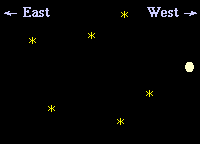-
Most of science and scientific theory eventually must confront "The Anamoly".
The anamoly represents and observation or experienment with an unexpected
outcome, relative to the current model. That is, the Truth, has been violated. How does science and culture deal with observed anamolies?
There are basically three possibilities:
- Ignore it
- Acknowledge it but claim its irrelevant to the model
- Use it as evidence that the model is incomplete.
History shows us that options 1 and 2 are the most frequent response. Option
3 requires admitting that your known Truth may be wrong  oops ...
oops ...
Recall the Truth as told by Aristotle concerning the Earth's place in the Cosmos

The crystalline sphere universe of Aristotle makes a simple prediction
 all the wheels move in the same direction.
This means that any planet should always move in the same direction,
with respect to the background stars (which are the coordinate system
here).
all the wheels move in the same direction.
This means that any planet should always move in the same direction,
with respect to the background stars (which are the coordinate system
here).
Yet, the retrograde motion of Mars was well known at the time.


Mars generally moves west to east (right to left) on the background of stars. But every 780 days it goes through period of 83 days during which it moves east to west against the stars, the retrograde motion. The retrograde period is centered around the time when Mars is in opposition - Mars is directly opposite the Sun. Thus, this phenomena could be established as repeatable and reliable after only a decade's worth of observations.
Plato gave his students a major problem to work on. Their task was to find a geometric explanation for the apparent motion of the planets, especially the strange retrograde motion. One key observation: as a planet undergoes retrograde motion (drifts westward with respect to the stars), it becomes brighter. Plato and his students were, of course, also guided by the Pythagorean Paradigm. This meant that regardless of the scheme they came up with, the Earth should be at the unmoving center of the planet motions.

One student named Aristarchus (of Samos 280 BC - Google Him) violated that rule and developed a model with the Sun at the center. He submitted to Plato, from his FaceBook page, the animated model shown below which reveals how, in that model, the retrograde motion of mars is the result of the Earth "overtaking" Mars in their mutual orbits about the Sun.
His model was not accepted because of the obvious observations against a moving Earth.


In order to preserve the geocentric cosmology of the time and to account for retrograde motion, Ptolemy had to make a model of epicycles. This makes the orbits of planets very complicated and violates the scientific search for simplicity.
A visualization of epicycles:


The Ptolemaic Moment will stand for about 1500 years with this model for planetary orbits remains unchallenged, partly because Ptolemy's model did improve the precision to which planetary positions could be predicted. Remember, however, the precision at measuring planetary positions was quite poor and therefore there was a large random error involved when comparing predictions with observations.
The Ptolomaic model represents an excellent example of "cultural" bias in science. Most citizens of the cultural wanted to accept the idea of the Earth being the center of the Universe (i.e. the earth was special) and therefore observations were molded in such a way so as to preserve that cultural norm. (Things may not be very different today).